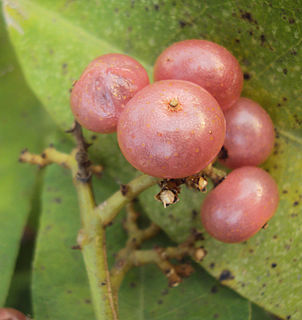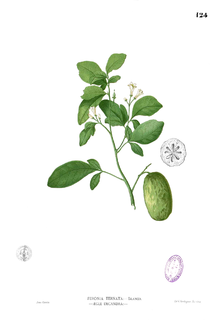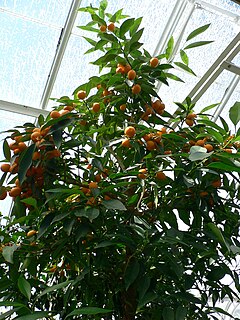
Kumquats, or cumquats in Australian English, are a group of small fruit-bearing trees in the flowering plant family Rutaceae. Their taxonomy is disputed. They were previously classified as forming the now-historical genus Fortunella or placed within Citrus, sensu lato. Different classifications have alternatively assigned them to anywhere from a single species, C. japonica, to numerous species representing each cultivar. Recent genomic analysis would define three pure species, Citrus hindsii, C. margarita and C. crassifolia, with C. x japonica being a hybrid of the last two.

Citrus is a genus of flowering trees and shrubs in the rue family, Rutaceae. Plants in the genus produce citrus fruits, including important crops such as oranges, lemons, grapefruits, pomelos, and limes. The genus Citrus is native to South Asia, East Asia, Southeast Asia, Melanesia, and Australia. Various citrus species have been used and domesticated by indigenous cultures in these areas since ancient times. From there its cultivation spread into Micronesia and Polynesia by the Austronesian expansion ; and to the Middle East and the Mediterranean via the incense trade route, and onwards to Europe and the Americas.

The Rutaceae is a family, commonly known as the rue or citrus family, of flowering plants, usually placed in the order Sapindales.

Citrus myrtifolia, the myrtle-leaved orange tree, is a species of Citrus with foliage similar to that of the common myrtle. It is a compact tree with small leaves and no thorns which grows to a height of three metres (10 ft) and can be found in Malta, Libya, the south of France and Italy.

Morinda is a genus of flowering plants in the madder family, Rubiaceae. The generic name is derived from the Latin words morus "mulberry", from the appearance of the fruits, and indica, meaning "of India".
Citropsis is a genus of flowering plants in the citrus family, Rutaceae. They are known generally as African cherry oranges. They are native to Africa.

Triphasia is a small genus of three species in the family Rutaceae, related to Citrus. The genus is native to southeastern Asia and New Guinea.

Clausena lansium, also known as wampee or wampi, from the Chinese huang pi (Clausena wampi), is a species of strongly scented evergreen trees 3–8 m tall, in the family Rutaceae, native to southeast Asia.

Amyris is a genus of flowering plants in the citrus family, Rutaceae. The generic name is derived from the Greek word αμυρων (amyron), which means "intensely scented" and refers to the strong odor of the resin. Members of the genus are commonly known as torchwoods because of their highly flammable wood.

Glycosmis is a genus of flowering plants in the citrus family, Rutaceae and tribe Clauseneae. It is in the subfamily Aurantioideae, which also includes genus Citrus. It is a genus of the subtribe Clauseninae, which are known technically as the remote citroid fruit trees.
Merrillia is a monotypic genus of flowering plants in the citrus family, Rutaceae, containing the single species Merrillia caloxylon. Its English language common names include flowering merrillia, katinga, and Malay lemon. In Malaysia it is called ketenggah and kemuning gajah. The species is native to Malaysia, Thailand, and Sumatra in Indonesia.
Monanthocitrus is a genus of flowering plants in the citrus family, Rutaceae. General common names for the genus include spotseed-lime and monanthocitrus.
The false oranges are a group of flowering plants in the Citrus genus, within the family, Rutaceae. They are endemic to New Caledonia.

Aurantioideae is the subfamily within the rue and citrus family (Rutaceae) that contains the citrus. The subfamily's center of diversity is in the monsoon region of eastern Australasia, extending west through South Asia into Africa, and eastwards into Polynesia.

Clymenia is a small genus of flowering plants in the family Rutaceae with two species. The genus is often included in Citrus.
Citrus indica is a species of hybrid Citrus known by the common name Indian wild orange.

Micromelum is a genus of eight species of flowering plants in the family Rutaceae.
Clausena excavata is a species of evergreen shrub that grows 1–2 metres tall, in the family Rutaceae, native to Bangladesh, Bhutan, Cambodia, China, India, Indonesia, Laos, Malaysia, Myanmar, Nepal, the Philippines, Taiwan, Thailand, and Vietnam. The plant is commonly by various names, including pink lime-berry, cama, cemama, cemamar, cerek, cerek hitam, kemantu hitam, secerek, semeru, and suntang hitam.

Clausena anisata (Willd.) Hook.f. ex Benth. is a deciduous shrub or small tree, belonging to the Rutaceae or Citrus family, and widespread in the Afrotropical realm or Sub-Saharan Africa, but absent from the drier regions. It is also found in tropical and South-East Asia, growing in India and Sri Lanka and extending as far as Queensland in north-eastern Australia and some Pacific islands. It is cultivated in Malaysia and Indonesia. As with other plants useful to mankind its large range of medicinal properties has led to a global distribution and its growth wherever the climate is suitable. It grows in higher-rainfall regions in savanna, thickets, riverine forest, disturbed areas and secondary forest, up to an altitude of 3000 m. The leaves, which are foetid when bruised, give rise to the common name 'Horsewood' or the more descriptive Afrikaans common name 'Perdepis', meaning 'horse urine'.

Citrus taxonomy refers to the botanical classification of the species, varieties, cultivars, and graft hybrids within the genus Citrus and related genera, found in cultivation and in the wild.














